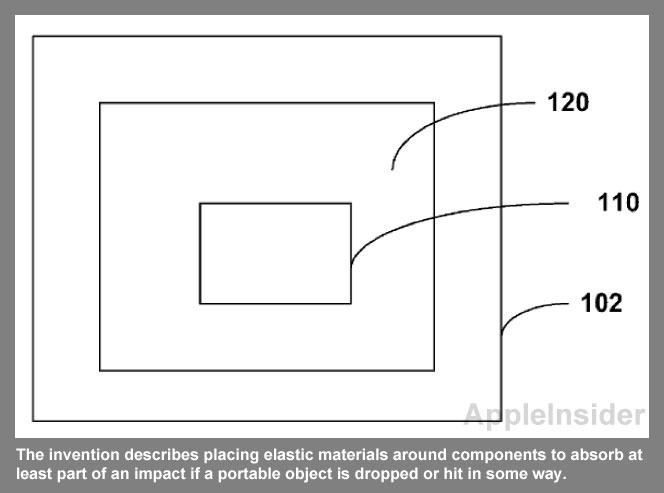U.S. Patent No. 8,248,777, entitled "Viscoelastic Material for Shock Protection in an Electronic Device," was officially awarded to Apple by the U.S. Patent and Trademark Office on Tuesday. The filing, discovered by AppleInsider, describes a "boundary element" that can deform in response to impacts to a device.
The invention, credited to Christopher Prest, was first filed with the USPTO in September of 2008. It describes placing elastic materials around components to absorb at least part of an impact if the object is dropped or hit in some way.
"An electronic device may be surrounded on all sides by material operative to absorb a shock to the electronic device component," the invention reads.
Materials selected for their viscoelastic properties could be selected to reduce shocks on the component. In the case of the iPhone, a thin rubber bezel rests between the Gorilla Glass display and the exterior bezel of the device.
For the purposes of the patent, the ideal material would have dominant elastic properties in a "large impact scenario," such as an iPhone being dropped from a great distance, while the material's viscous properties would be dominant in the "small impact scenario," such as smaller drops that occur more frequently.
The rubber screen gasket and seal found inside the iPhone is actually part of the frame assembly of the device. The tiny layer provides a tight seal and flush appearance to the front of Apple's iOS devices.
 AppleInsider Staff
AppleInsider Staff




-xl-m.jpg)



 Malcolm Owen
Malcolm Owen
 William Gallagher
William Gallagher
 Mike Wuerthele
Mike Wuerthele


 Thomas Sibilly
Thomas Sibilly
 Wesley Hilliard
Wesley Hilliard
 Marko Zivkovic
Marko Zivkovic







35 Comments
We're going to see 'shopped pictures of iPhones with undercarriage lighting, spinning Home Buttons, and 300w subwoofers, aren't we?
And NOW Apple is patenting a rectangle, so finally all those lies are truth.
Apple patenting more ingenius rectangles...
We're going to see 'shopped pictures of iPhones with undercarriage lighting, spinning Home Buttons, and 300w subwoofers, aren't we?
And NOW Apple is patenting a rectangle, so finally all those lies are truth.
Amazing how you're almost always first to comment.
"An electronic device may be surrounded on all sides by material operative to absorb a shock to the electronic device component,"
Not sure where the invention is here... hardware has been designed like this for years. Mil spec stuff, even good case construction meets this because a case is designed to absorb a shock when dropped.
You guys it's not just rectangles, it's concentric rectangles. Big difference.